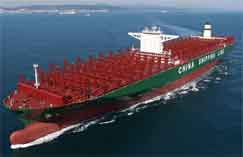| |
|
| |
|
 |
Supply
Chain by the Numbers |
| |
|
| |
- May 3, 2018 -
|
| |
|
| |
|
| |
|
| |
April PMI Continues to Show Manufacturing Strength; Anheuser-Busch Going with Hydrogen Fuel Cell Trucks; Maersk CEO Calls for End to Government Ocean Carrier Subsidies - but Container Shippers are Slowing New Ship Orders |
| |
|
| |
| |
| |
| |
57.3% |
|
That was the level of the US Purchasing Managers Index for April from the Institute for Supply Management. That was down 2 percentage points from the March reading of 59.3, but still well above the 50 mark that separates manufacturing expansion from contraction. It also means the overall economy grew for the 108th consecutive month. In still better news, the New Orders Index registered 61.2, down just a little from March but still at a very strong level, in a good sign for future manufacturing activity. Here's the bad news: The Prices Index registered 79.3 in April, a 1.2 percentage point increase from the March reading of 78.1, indicating higher raw materials prices for the 26th consecutive month. That extremely high level means the vast majority of companies are seeing higher input costs, as inflation is re-entering the supply chain after being absent for many years. In fact, the Prices Index is at its highest level since April 2011, when it registered 82.6. Respondents indicated prices were up in the month in 17 of the 18 commodity categories tracked by ISM, and the 18th was flat. What do supply chains look like in an inflationary period? Most of us can't remember.
|
|
|
| |
| |
|
|
|
That's about how much it costs currently to ship a container from Asia to Northern Europe – less than half of the $1400 or so viewed as the breakeven rate for the move. Rates are slightly better but not much from Asia to US East and West Coast ports. Face with this dismal rate environment and continued overcapacity in the industry, Maersk Line CEO Sore Skou this week that some governments to withdraw their financial support for container shipping lines, saying subsidies and other support are causing the overcapacity. "I don't think any government needs to throw money at container shipping, building ships that are not needed," Skou told a maritime conference in Singapore. He didn't mention specific carriers, but shipping lines such as state-run Chinese Cosco Shipping, South Korea's Hyundai Merchant Marine. And Taiwan's Yang Ming Marine Transport have been benefiting from cheap state financing, bailouts and other perks for years. In some cases, such as in South Korea, the government subsidies support ship builders in the country and reduce shipping costs for South Korean export industries. SCDigest thinks it is unlikely these governments are going to listen to Mr. Skou.
|
| |
| |
|
| |
| |
| |
1-1.2 Million |
 |
That is the new forecast from the analysts at Drewry Shipping as to the amount of new capacity in terms of TEU that will be added to the global container shipping fleet in 2018. That forecast is down some 600,000 TEU from Drewry's forecast just six months ago, as the company acknowledge such estimates are very difficult, as "the orderbook is constantly evolving as deliveries are made and new orders come in, while demolitions and the occasional cancellation also reduce the pot." Why does it matter? Because that would mean 2018 would be the third straight year of relative asset discipline by the carriers, after many years of adding capacity much faster than slowing container volumes. In fact, the new supply growth forecast for the current year is lower than demand growth projections. Based on the level of deliveries, "the market will still be over-supplied, but not catastrophically so, and certainly showing signs of improvement" – if you are a carrier that is. It is not such good news for shippers. And the megaship trend, or what Drewry calls Ultra Large Container Vessels (ULCVs), meaning ships of 18,000 TEU or more, will continues to gain advance. Drewry says ULCVs will comprise almost 40% of total TEU deliveries in 2018 and nearly 70% by 2020.
|
| |
| |
| |
|
|
|
| |
 |
 |
| |
|
|
| |